Published
on 9
Jan 2018
|
All rights reserved.
|
|
|
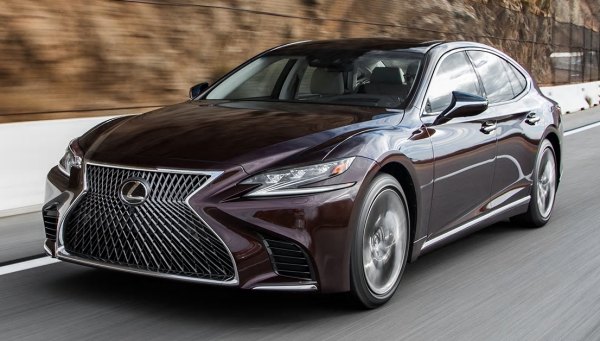
|
|
From
the dullest to the sharpest looking, can the new LS strike to the top
of the segment?
|
|
You
know what Lexus LS stands for: impeccable refinement, conservative
style, civilized but slightly boring driving manner. These have been
the genes of the LS since its birth in 1989. The redesign in 1994, 2001
and 2006 just served to reinforce this image. So far so good.
Unexpectedly, Lexus suddenly dropped a bombshell on last year’s Detroit
motor show. The new, 5th generation LS takes a U-turn on styling
direction. Not only the conservative approach has been ditched, it has
taken a bold step forward. In fact, I think it is easily the sharpest,
sportiest looking limousine on the market – save Aston Martin Rapide
and Lagonda, of course. Its nose is pin-point sharp, its bonnet is
sportscar-low, its side profile is Tesla-sleek, and its massive
“spindle grille” looks as hungry as Jaws. Standing next to the outgoing
LS460, you cannot believe that they are father and son. Even by the
standards of the 1980s Japanese motoring industry, its change is
dramatic. Thanks to Akio Toyoda, the cowboy CEO of Toyota group who
prefers sports cars and radical expression.
Is it too radical to the target audiences of luxury limousines? Well,
probably, but this author always appreciates diversity. While taste is
subjective, this car is undoubtedly refreshing to eyes, as it combines
sexy body shape with elegant details. My only criticism is that its
side looks remarkably close to that of Tesla Model S, in particular the
window profile, which might raise doubts about originality.
Understandably, the Tesla has been outselling all other F-segment cars
in the US market. It is now a model for learning.
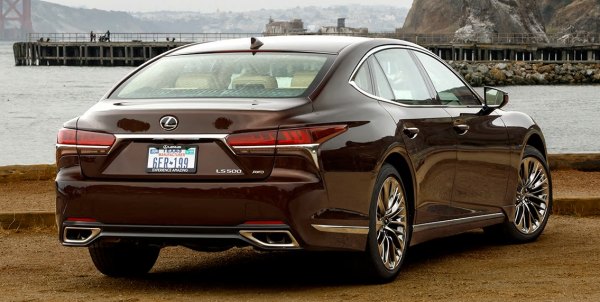
|
|
Weighing
close to Rolls-Royce and Bentley, the sportscar look just don't tell
the full story.
|
|
One victim of the expressive styling is aerodynamics. Its drag
coefficient is increased from 0.26 to 0.28, though hybrid model is
slightly better at 0.27.
The new LS is quite a lot larger than the old car. At 5235mm long and
3125mm in wheelbase, it is longer than even the long-wheelbase version
of its predecessor. No wonder it is available in only one standard size
this time around. It also gains 25mm in width, but the roof is lowered
by 30mm. To realize the coupe-like appearance, Lexus worked hard on the
mechanical side. The new GA-L (global architecture-luxury) platform,
shared with LC coupe, emphasizes on low placement of engine and compact
suspensions. This enables the bonnet to be lowered by 30mm compared
with the old car, and the front fenders can be set remarkably close to
the wheel arches and the 20-inch wheels. At the back, the boot lid is
lowered by 40mm to help the sleek profile, although it reduces luggage
space to only 480 liters. Hybrid model loses another 50 liters due to
the additional battery.
By using a lot of high-strength steel, aluminum sheets (bonnet, boot
lid, front fenders and doors) and cast aluminum (front and rear
suspension towers),
the monocoque body is said to be more than 90kg lighter than the old
one. Somehow, manufacturer’s figures show that the whole car gains at
least 200kg! The lightest rear-drive model now tips the scale at 2135
kg, while an all-wheel-drive, fully loaded hybrid model could reach
well over 2.3 tons. It is significantly heavier than the rivalling
Mercedes S-class, BMW 7-Series and Audi A8, actually closer
to a Rolls-Royce Ghost or Bentley Flying Spur! The sportscar look just
don't tell you the full story...
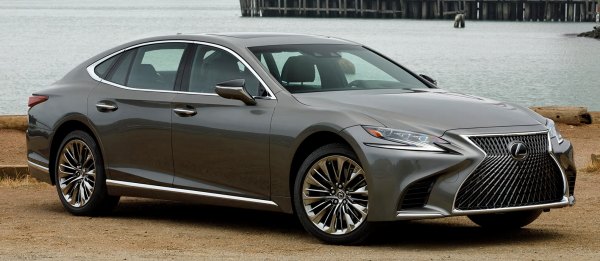 |
|
Learning
the bad habit from German, LS500 is powered by not a 5-liter V8 but a
3.5-liter twin-turbo V6...
|
|
Like the LC Coupe, its suspensions are multi-link setup all-around. Air
suspension is optional, as is AWD system. F Sport package may add
rear-wheel steering, active anti-roll bars and variable gear-ratio
steering, but unlike its German rivals, the Lexus is not available with
the latest
road-scanning active suspension. Its semi-autonomous
driving technology is also rather basic. We’d better call it adaptive
cruise control. Self-parking? "Why don't you do it yourself?" Lexus
asks.
The powertrain is a mixed bag. Learning the bad habit from German,
LS500 is powered by not a 5-liter V8 but a brand new 3.5-liter
twin-turbo V6 called V35A-FTS. With 88.5mm bore and 100mm stroke, this
engine is tuned for torque, which peaks at 442 lbft from 1600 to 4800
rpm. Maximum output is relatively modest at 416 horsepower. It is not
quite as powerful as the V8-powered BMW 750i, while the 6-cylinder
Mercedes S500 is not hampered by as much weight. Lexus claims the car
good for 0-60 mph in 4.6 seconds, but in the real world it feels like
more than 5 seconds. Fortunately, the V6 keeps the typical smoothness
and quietness of Lexus. The 10-speed automatic transmission, shared
with LC, normally shifts smoothly, but downshifts could feel harsher in
a hurry.
Meanwhile, LS500h shares the hybrid powertrain with LC500h, which
combines a naturally aspirated Atkinson-cycle 3.5-liter V6 and 2
motor/generators for a total output of 354 hp. The so-called
Multi-Stage Hybrid system mates a planetary CVT with a 4-speed
automatic to enable 10 artificial ratios. Driving leisurely, the
powertrain combo feels smooth and refined. More enthusiastically, it
struggles with lots of revs and noises as it lacks torque to cope with
the immense weight. Lexus claims 0-60 in 5.1 seconds, which is
again optimistic. Both performance and refinement disappoint, while
fuel
economy no match for its diesel rivals.
Want a true V8 to rival Mercedes S560, BMW 750i or Audi A8 4.0TFSI?
Sorry, it is not on the product plan. I suspect will never be.
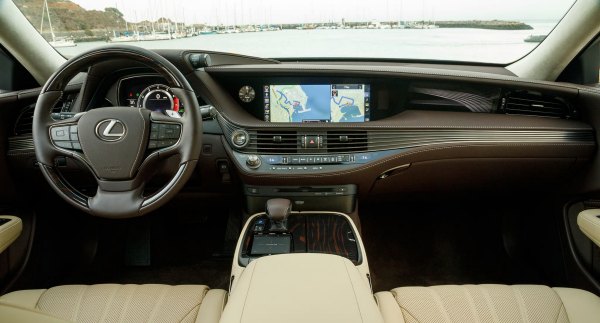
|
|
Lexus
should have learned from Tesla for its infotainment system...
|
|
The chassis is another mixed bag. Lexus lovers will be shocked with its
firmness, especially with the F Sport package. On smooth roads the LS
rides comfortably and quietly, just like any cars in this class, but
its air suspension and 20-inch low-profile tires are unsettled with
sharp bumps more so than its main rivals, even in Comfort mode. Speed
bumps and sharp-edged, high-frequency bumps are dealt with pain. Tire,
suspension and wind noises are also a bit more than expected for a
Lexus. This is the first time the Lexus flagship loses the ride
refinement game to the German Trio (S-class, 7-Series and A8).
What a shame!
On the flipside of a stiffer ride should be a sportier handling. This
is partly true. The F Sport’s steering is noticeably weightier and more
direct than the Lexus of old. It makes the car feels immediately
sportier. There is some information available from the rim, too,
although not to be confused with a sports car’s. Thanks to the new
steering, the turn-in is sharper as well. Body control seems to be
pretty good. However, push the car harder in tighter corners will
reveal all its 2.3 tons of weight and 5.2 meters of length. It doesn’t
shrink around you like an XJ, 7-Series, A8 or even an S-class. Blame
that weight.
Maybe it should recoup some points from the cabin? At the first glance,
yes. The interior design is really refreshing, being radical and
different from the class norm. It has a curvy and flowing dashboard,
tastefully styled door panels and exquisite finishing. The LFA-style
instrument is unique and sporty. Attention to details is evident on the
hand-cut glass accents, art wood accents and pleated fabric trims on
the doors, which reflect traditional Japanese craftsmanship. On the
downside, some small switchgears are made of cheap plastic, an
oversight
won’t happen on Mercedes and Audi.
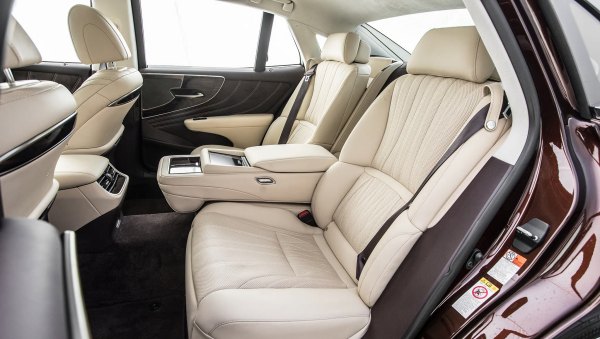
|
|
Despite
the longer wheelbase, the cabin feels tighter than before.
|
|
The bigger issue is space. Despite the longer wheelbase, the cabin
feels tighter than before. Rear legroom is sufficient for tall guys but
not as excessive as others in the class. Rear headroom is compromised
by the lower roof. Although Lexus deliberately has the sunroof
shortened, rear headroom is still marginal for a 6ft 3in passenger. On
the plus side, the massaging seats are comfortable. Executive package
adds a reclining rear seat, and the front passenger seat can slide and
flip forward to free up the legroom behind. The Mark Levinson sound
system is great, as always.
Sadly, Lexus’ infotainment system is sub-standard. While the 12.3-inch
recessed TFT screen provides clear and crisped image, the operating
system is troublesome, taking too many sub-menus, swipes and taps to
navigate to the desired functions, even functions as basic as switching
on and off the heated seats! The touchpad on transmission tunnel that
controls the system is also difficult to use in move. Instead of
exterior, Lexus should have learned from Tesla in this respect.
As seen, the new LS is substantially deviated from its established
formula. It looks as striking as the old car boring. It tries to be
sporty and different. Unfortunately, the result is seriously
compromised. While it is really sportier to drive, it is hampered by
its weight thus performance and handling are both unremarkable.
Meanwhile, the impeccable ride comfort and refinement of the old Lexus
has taken a noticeable setback. In addition to an annoying control
system, it shows too many rough edges than a Lexus, or just any cars in
this class, is expected. Unless you can’t live without its striking
look, there seems to be no good reason to choose it instead of the
brilliant S-class, A8 or 7-Series. Even Hyundai G90 manages to find its
own position on the market. It is worth praising that Lexus dares to
walk out of its comfort zone and try to redefine itself, but as the
results show, the effort is unfulfilled.
|
Verdict: LS500:
   / LS500h:
/ LS500h:  
|
|